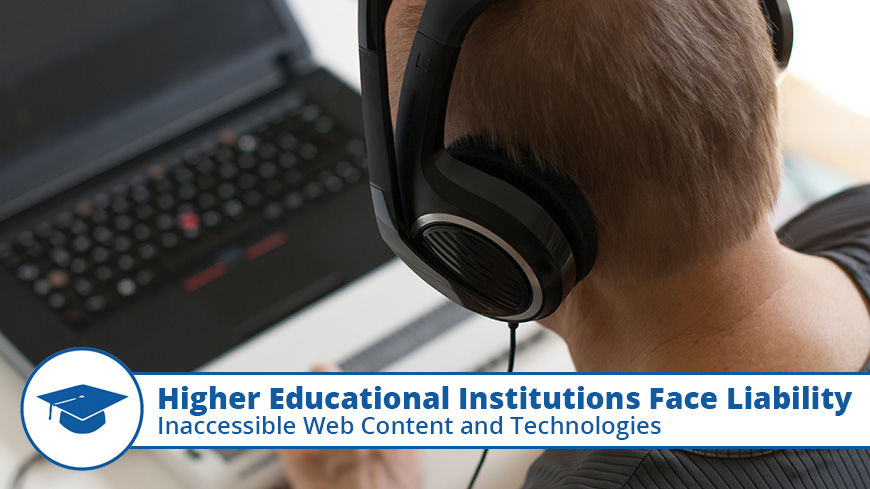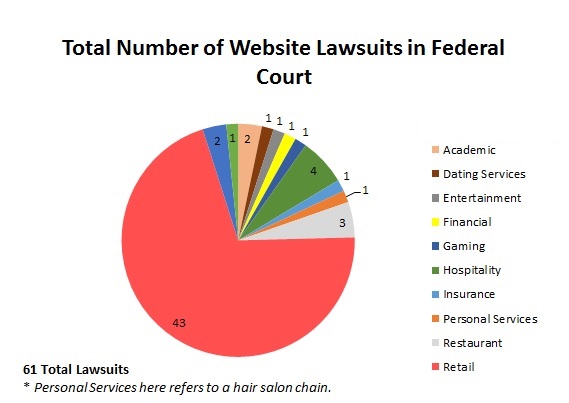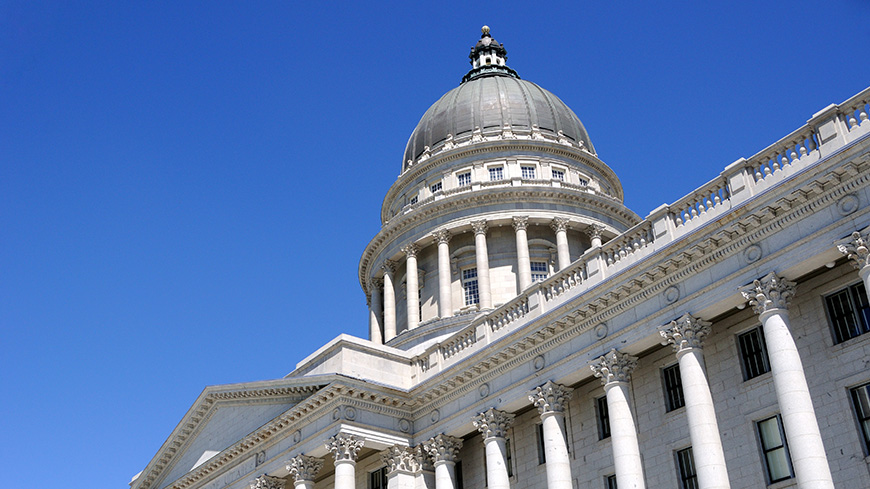Higher Educational Institutions Face Liability for Inaccessible Web Content and Technologies
Last Edited September 11, 2023 by Garenne Bigby in Accessibility Testing

The topic of website accessibility is complicated and evolving. Many businesses have been caught off guard because of the Department of Justice's dynamic positions on the issue and delayed regulations. Because of this, the attorneys of the plaintiffs are making their money on the uncertainty. There has been an influx of lawsuits and demand letters regarding public accommodations and inaccessible websites. As have been done with Title III lawsuits, all web accessibility lawsuits are being tracked and logged to spot the trends in lawsuits.
Since the beginning of 2015 alone, there have been just over 60 lawsuits that allege a defendant's website is inaccessible and violates Title III of the Americans with Disabilities Act that were filed or removed on the account of the federal court. All of these 61 cases were filed in 5 states; California, Massachusetts, New York, Pennsylvania, and Washington—with a small amount being filed virtually.

The total number of lawsuits have been broken down by category, sorting through which industries are targeted by lawsuits regarding website accessibility. Retailers are the clear targets, with an accumulated 42 lawsuits. All other industries fall somewhere between 1 and 4 lawsuits, with academic websites making up 2 of the lawsuits. These two universities filed a motion to dismiss the lawsuits against them, but the judges did reject these motions, which allowed the case to keep moving forward and continue to discovery. While many of the lawsuits filed against businesses in regards to website inaccessibility have settled, more new cases do continue to be filed.
In regards to higher education institutions and website accessibility since the beginning of the internet, there have been numerous lawsuits, complaints, and settlements.
Atlantic Cape Community College faced a lawsuit from two blind students and the National Federation of the Blind, accused of discrimination on the basis of disability. All involved came to an agreement that also involved a third party consultant that would work to prevent discrimination against students that are blind.
The school was then bound to:
- Conduct an audit of their technology, and then based on that audit, they would develop a plan that would make all electronic and information technology used by students accessible to everyone, including those with disabilities. This would need to be done within three years of the technology audit.
- Make all of their websites accessible to the blind population within 240 days of execution of the consent decree
- Change the integrated library system and website in order to be made accessible to blind students
- Develop a plan that would provide accessible materials for instruction—this would include textbooks, materials for the course, and tactile graphics—to students that are blind or have other disabilities
- Call for complete cooperation from staff, faculty, and the college's Disability Support Services office
- Review and/or revise the school's procedures and policies regarding students with disabilities , including reporting any failure to resolve a student's accommodation request or complaint
- Require all personnel to be trained on the Americans with Disabilities Act and the college's policies for accommodating those students that have disabilities
- Train such students on their rights and the procedures that are available to enforce their rights.
In 2009, Arizona State University faced a complaint for launching a new program titled Human Event, in which the 59 students were given a Kindle DX ebook reader. The plaintiffs complained that the Kindle, in its current state, was not accessible for blind individuals because all menus and controls are displayed only visually—with no audio option. Though the device does have text-to-speech (TTS) technology, it is impossible for those that are blind to configure these settings, turn on the TTS feature, or select books. In its original state, the device's menus and controls do not utilize the TTS option. Because the classroom component of the program ended at the conclusion of the spring 2010 semester, students has to fulfill their commitments to the course beyond this with no classroom setting.
The complaint, National Federation of the Blind, American Council of the Blind, et al. v. The Arizona Board of Regents and Arizona State University, alleged that by offering this e-book that is not accessible to blind students, ASU was in violation of section 504 of the Rehabilitation act of 1973 and title II of the ADA. While the National Foundation for the Blind and American Council of the Blind requested investigation by the Department of Justice, the Arizona Board of Regents and Arizona State University disputed the allegations. How did it all turn out?
- Both parties agreed that unnecessary barriers that would prevent access to materials should be eliminated, and that new technology for e-books that would benefit sighted people would have the potential to benefit the blind as well.
- ABOR and ASU voluntarily entered the agreement, although they did not admit to (and explicitly denied) that they violated any of the items in which they were accused.
- ASU remained committed to complying with the law and expresses their obligation to to provide disabled students with equal opportunity to obtain the same benefits and results, and to reach the same level of achievement using the most coordinated settings appropriate for the person's needs.
- The Plaintiffs did content that the e-book was not a device that is accessible to the blind individuals, and acknowledged that they must use an e-book in which the blind students would access and acquire the same information as seeing students, engage in the same interactions, and use the same services in which were offered to sighted individuals.
- The NFB and ACB did agree to dismiss the Action against ASU within three business days of the Agreement execution date.
Not all higher educational institutions have been so fortunate as to reach an agreement like those previously mentioned. In 2012, Florida State University resolved a lawsuit that ended with the institution paying two blind students $75,000 each. These two students accused the University of discriminating them due to technology that was inaccessible. In addition to the $150,000 paid, the university agreed to continue their efforts to make all courses accessible to all students, regardless of disability. The NFB also had a hand in reaching this settlement with Florida State University. The school did not admit to any wrongdoing or liability.
The two students argued that their math course relied on an e-learning system that was not accessible to those with disabilities. The lawsuit stated that these students were not able to access the software that was used to complete homework and tests. This specific math course also relied on “clickers” that students used like a remote to answer multiple-choice questions during lectures—which was also inaccessible to the students with disabilities.
How will institutions proceed from now on? Recently, courts have been doing everything in their power to find plaintiffs with zero legitimate reason or intention to visit a particular business have the standing to sue under Title III of the ADA. Following this, there has been a pointed increase in the number of Title III lawsuits. Through the ruling of Spokeo, Inc. v. Robins, courts may change the way that they interpret requirements for cases that include a Title III lawsuit. Though Spokeo was not an ADA case, it may impact how courts choose to rule in Title III litigations. In Spokeo the plaintiff alleged that the information provided about him through the background check was inaccurate. This included his age, marital status, and education. The plaintiff charged the company with willingly violating the Fair Credit Report Act through failure to adopt procedures that would ensure the accuracy of its reports.
Long story short, the court determined that the analysis was not complete because it failed to reckon that the injury to the plaintiff was sufficiently “concrete”. In order to qualify as a case, the injury has to be concrete—this means that is must actually exist and be real, rather than abstract.
This case raised many questions for the Americans with Disabilities Act Title III:
- Does a “tester” for the ADA that travels to establishments (with no intention to purchase goods or services) solely to evaluate their compliance suffer any concrete injury as processed in Spokeo?
- Do plaintiffs with the ADA have any standing to challenge every barrier related to their disability at an establishment, or do they only challenge those barriers that they actually encounter during their own visit?
- Does a perpetual ADA plaintiff's lawsuit history hold any bearing on whether or not they have suffered concrete injury in any given case?
Though the implications of Spokeo in regards to ADA Title III cases is not absolutely clear at this point, the decision can let establishments breathe a little easier. This ruling has the ability to prompt lower courts to dissect whether or not there are sufficient concrete injuries in Title III cases.
While good news for businesses, this is bad news for higher education institutions. When a student with disabilities enrolls in a course, they must be provided with technologies that are accessible to individuals with any disability. But what about prospective students? The school's website must be accessible to those who would like to apply for admission. Three students, along with an advocacy group, have sued four law schools in California with the argument that the online application system fails to be accessible to students that are blind. The four schools in question either highly encourage or require their prospective students to apply through the website of the Law School Admission Council, which the blind students claim that they have to seek assistance to use. The NFB assisted the students in arguing that the system did amount to discrimination against the students and suing the schools as well as the admission council. The website for the admission council is not able to be converted to speech or Braille by the software that is typically used by blind individuals to read websites. Does this violate Title III of the ADA? Spokeo may influence the way that the court proceeds—how will the students define their concrete suffering?
Outside of the classroom deaf sports fans are calling for captions at sporting events. In 2009, the National Association of the Deaf (NAD) along with a law firm filed a lawsuit on behalf of an Ohio State University sports fan Vincent Sabino. The sports fan is deaf and asked for OSU to offer captioning for announcements that are made through the public address system through the entirety of OSU's events. Because the university does not provide captioning, the plaintiff claims that they are in violation of title II of the ADA as well as the Rehabilitation Act, section 504. Mr. Sabino says that “I have attended games every year since I was a young child. All I want is to be involved in the game with my family and all those who attend Ohio State sporting events.”
It is getting harder and harder for higher education institutions to bypass website accessibility. In 2014, the U.S. Department of Education entered into an agreement with Youngstown State University to ensure that the college's websites will abide by the federal rights laws that prohibit discrimination based on disabilities.
The university's websites were investigated by the Office for Civil Rights and concluded that the school was not compliant with two federal laws that are enforced by the office. YSU's website was in violation of section 504 of the Rehabilitation Act, as well as Title II of the ADA. The OCR also found that the institution was not fully compliant with the regulatory requirements in regards to the publication of a notice for nondiscrimination in its relevant documents. While Youngstown State University did not dispute these results, they did ensure that the contents on their websites would be accessible to those with disabilities and would provide an equal opportunity for all individuals to participate in as well as benefit from their online learning environment.
The compliance with the ADA and Rehabilitation act are not only required within the course setting within a higher educational institution, the compliance is also necessary to benefit the individuals that are aiming to apply to the institution as well. The evidence is clear, as there are a number of institutions required to pay the plaintiffs for their damages.
References
Higher Ed Accessibility Lawsuits, Complaints, and Settlements
Spokeo May Raise the Bar for Standing in ADA Title III Cases
Website Accessibility Lawsuits By the Numbers
Related Articles
- The Honest Truth About Accessibility Overlays
- EU Accessibility Act 2025
- How to Develop Organizational Policies on Web Accessibility
- How to Involve Users in Web Accessibility Testing
- United States Web Accessibility Laws
- Where To Learn Web Accessibility (A11Y)
- Web Accessibility Certifications for A11Y Practitioners
- What is Web Accessibility?
- What Is Section 508 And Who Needs to Be Compliant?
- Web Accessibility and Search Engine Optimization (SEO)
- Accessibility Testing Best Practices to Follow
- International Web Accessibility Laws and Policies
- Assistive Devices for Impairments in Hearing, Voice, Speech, and Language
- Web Accessibility Checklist
- Web Accessibility Compliance for Inclusivity
- The Rehabilitation Act of 1973 (Rehab Act)
- Testing Accessibility Without an Accessibility Testing Tool
- The Twenty-First Century Communications and Video Accessibility Act (CVAA)
- Monitor Your Website Health with DYNO Analytics ™
- What is the Americans with Disabilities Act (ADA)?
- 70 Web Accessibility Resources for Designing with Inclusivity
- Website Accessibility Best Practices and Standards
- How Website Accessibility Affect Persons with Disabilities
- Web Accessibility Lawsuits Set to Increase Under Trump
- Web Accessibility Compliance and Your Organization
- Building a POUR Website: the 4 Principles of Accessibility
- Accessibility Testing: Considering the User’s Perspective of Accessibility
- WCAG: Web Content Accessibility Guidelines Explained
- How to Write for Web Accessibility
- How to Develop for Web Accessibility
- How to Design for Web Accessibility
- Top 25 Awesome Accessibility Testing Tools for Websites
- How Accessibility Can Benefit Your Website
Create Visual Sitemaps
Create, edit, customize, and share visual sitemaps integrated with Google Analytics for easy discovery, planning, and collaboration.
Popular Tags
Search Engine Optimization SEO Accessibility Testing Create Sitemaps Sitemaps UX User Experience Sitemap Generator Content Audit Visual Sitemap GeneratorGet Started with DYNO Mapper
Join thousands of professionals using the most advanced visual sitemap tool to simplify discovery, IA, and content planning.
👉 Start Your Free Trial — No credit card required.



